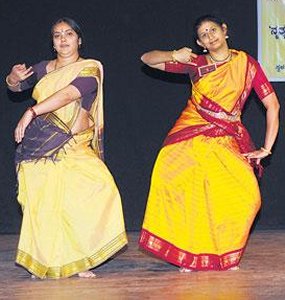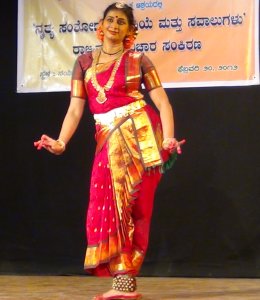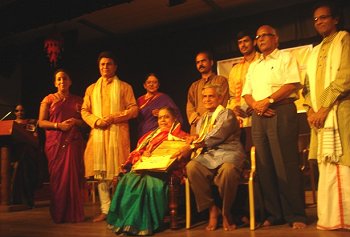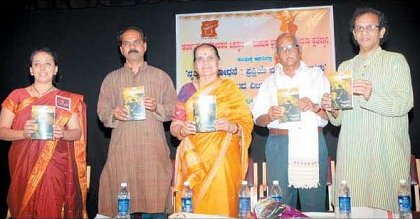
|   |

|   |
Workshop/seminar on 'Research in Dance – Process and Challenges' March 7, 2012 Noopura Bhramari Research Association and Karnataka Researchers Federation, Bengaluru jointly organised a one day workshop/ seminar on ‘Research in Dance – Process and Challenges,’ the first of its kind in Karnataka. It was held on 20th February 2012 on the day of Mahashivrathri, at Nayana Auditorium, Bangalore. On this occasion, ‘Dance Researchers’ Association’ was also inaugurated. The day long events were inaugurated by Leela Devi R Prasad, (Former Minister, Dept of Kannada and Culture). The Karnataka Researchers’ Federation expressed its pride to support a research based workshop, and assured its participation and support to all in the research field from all disciplines in such endeavours in future also. A special edition of Noopura Bhramari including data on PhD, D. Litt research work done and undertaken till date by various researchers in Karnataka with respect to dance, folk dance, Yakshagana and the list of dance books and periodicals in Karnataka was released by the legendary multilingual scholar and poet, Shatavadani Dr. R Ganesh. As Dr. HS Gopala Rao (Epigraphist / Historian) was unwell, the benedictory message and expert note sent by him was read by Manorama BN, President and Editor, Noopura Bhramari Foundation. He conveyed the need for interdisciplinary studies. No art is independent; hence an artiste is complete and competent in his creation, only when he is best acquainted with all related arts. He summed up saying that this outlook and vision was called research orientation. The sessions were presided over by Dr. Shesha Shastri, renowned scholar in Kannada and Cultural history of Karnataka. In his key note address, he drew attention towards the present situation in the field of dance. Amidst gurus of traditional approach and experimental outlook, there are as many gurus who are just opportunists, under qualified but pose as experts of dance. They lack the necessary discipline, patience and commitment. The best way to improve the situation is to make these people aware of the Natya Shastra. But the knowledge of Natya Shastra should not be restricted to gurus and students. It should be accessible to the spectators which will make the process of rasa more meaningful. Then, he insisted on the insight for research in artistes which alone would improve the quality of performance. He added that one cannot question a researcher’s authenticity in his dedication to the work, but one has all the rights to question the authenticity of the work, as newer and newer works are born of such questioning. Thus, Dr. Shesa Shastri clearly demarcated between the personal and impersonal factors in research. He emphasized the need to understand the methodology first. All research will not have same methodology and methodology itself will not become a research. One does not become a poet just by learning language and aesthetics. He has to first understand different methodologies and follow those which help him to project his sincerity and logic. The degree does prove that he is a researcher. He should possess the quality of humility in him. Manorama BN welcomed the gathering and provided introduction. Dr. Revayya Wodeyar, Secretary, Karnataka Samshodhakara Okkuta, presented vote of thanks. Tejaswini sang the invocatory song while Niveditha Srinivas did the compering. The morning sessions were presented by resource persons. The first paper was presented by Dr. Karuna Vijayendra, art historian, Bengaluru. Her paper on ‘Mahanata - an appraisal,’ was received with astonishment at the magnitude of research that went behind it. The ‘roudra’ form of Shiva of Vedic period took to a peaceful form, sporting white robe with beautiful expression, by the time of the Chalukyas. ‘Mahanata’ is one such sculpture of Shiva with eighteen hands at the Badami caves of the early Chalukya dynasty. It was not called as Nataraja as is called today. Moreover, though Nataraja originated in Tamil Nadu, its root can be traced to Kashmir. The scholar observed that the dance sculptures of Saptha Matrikas with the Parivara of Shiva are found only in Badami Chalukyas of Karnataka. Besides identifying the relevant karanas in the sculpture, the scholar also introduced to the participants with the necessary visuals, the uniqueness of the movements in the Karnataka style. The lecture was supported by demonstration of karanas by Dr. Shobha Shashikumar.  Mahanata  Shobha Shashikumar The next paper ‘Confluence of Theory and Practice in Bharatanatyam’ was presented by Dr. Shobha Shashikumar, researcher and performer, guest lecturer, Jain University, Bangalore. Her paper summed up the meeting point of theory and practice in Bharatanatyam. An insight into the shastras would help identify the lacuna in practice. Such studies are an urgent need in Bharatanatyam, as there has been a dangerous deviation from the shastras. Many dancers are not aware of the background of dance. Dance is not a mere technique. It is a flowing river. It is supported by sculpture, painting, history, etc. The knowledge of the other facets of art is a must. But in today’s world, pure dance (nritta) and abhinaya are looked at in different planes. Nrutta is considered sans emotion which is the height of ignorance. The importance of nritta is in preparing the minds of the spectator for certain conditions in the presentation. And presenting dance numbers which are taught at basic level hardly lead to Rasotpatti. The lecture was supported by demonstration by Keertana, disciple of the speaker and helped in understanding how Natya Shastra techniques would enhance performance techniques. The session triggered an interesting and vigorous discussion. The next paper was presented by Manorama BN, researcher, editor, Noopura Bhramari, on the ‘Representation of dance in the Kannada novels.’ An exhaustive approach in the analysis of the novels was evident from all angles including language, characterisation of heroines, their representation and influence on the society, its adaptability to other media, and finally the extent of dance content in these characters. She observed that the more the novels work on tightness of content and portrayal of technique, the more are the chances of them being adapted to other mediums such as theatre, cinema, thus realizing in a fruitful, visual touch. Most of the historical novels have worked on Natyarani Shantala, as the seed of the plot. These in turn widen the scope of looking at the historical perspective in different ways. Apart from such novels there are many more in other languages as well which bring in the element of dance in them, throwing light on how the Indian literary field has utilized dance leading to parallel developments in both the fields. She concluded by opening opportunities to work more in this direction. The second part of the convention had paper presentations by young researchers. The session included brief papers by serious researchers working for their thesis. Shalini presented a paper on ‘Placement of the compositions of the Tanjore brothers in today’s Bharatanatyam.’ She clearly brought out through a graphical depiction, how the compositions of the Tanjore brothers in the format of jathiswarams, shabdams, varnams, padams, javalis and thillanas are the most danced in the conventional schools, despite the fact that many new composers are making a mark in the field. Next, Sapna Nayak from Goa presented her paper on ‘The development and changes in the aharya of Bharatanatyam in the period between 1910 and 2010.’ Her observations were well supported by old and new photographs with an exhaustive collection. The third speaker was Sudhir Kumar, who spoke on the ‘Application of film music to Bharatanatyam.’ He argued how many lyrics from the films were suitable to Bharatanatyam as the sahitya and sangeetha offered scope for representation. The last paper was of Dr. Satish Kumar Andinje on ‘Folk dances of coastal Karnataka as a medium of communication’ but presented by Padmanabha, due to the inability of the former to attend the seminar. Satish enquired about how effective were the folk dances in the communication of social messages. He presented a survey report where folk dances for social, cultural and spiritual values were evaluated. The sessions were debated upon and thereby had a vigorous approach. The following session saw an open discussion in the topic ‘Relevance of dance research; responsibilities, processes and opportunities.’ Shatavadani Dr. R Ganesh briefed about the dance presentations, their responsibilities involved, problems faced, methodology followed and opportunities available. Leading and conducting the questions and answers session, he enlightened on research work in the dance field. The discussions were encouraged, supported and enriched by the involvement of Dr. R Ganesh and Dr. Shesha Shasthri.  Pratibha Samaga receives award  Release of special edition Noopura Bhramari Foundation conferred the ‘Best Dance Critic award of the year’ on Pratibha Samaga, and her husband ML Samaga, (President of Karnataka Yakshagana Bayalayata Akademy) was by her side. Respected guru of Mysore style, Lalitha Srinivasan being present at the time, did the honours of garlanding the awardee. Pratibha shared her experiences after receiving the award. Vishnuprasad, trustee of Noopura Bhramari, read the certificate of honour while Shalini Vittal introduced the awardee. Renowned Bharatanatyam dancer and actor Shridhar, the chief guest of the evening, delivered his address to the sabha. He stressed the importance of unifying theory and practice in dance. He added that theory helps to sink into the innermost depths of sahitya from where the dance should spring out, lest the dance should be akin to a parrot’s delivery of the teacher’s choreography. Without understanding the ‘sthayi rasa,’ without a deeper knowledge of the subject, a dancer ventures into performance these days. It has become a common notion that dance is from the ruins. He then pointed out to the time of Devadasi who were known for their perseverance, discipline and honesty. He expressed his grief over fading away of such values with time. The hereditary dancers, learning dance for years, know the mammoth form of art but those who do a short visit to classes are a threat to the field. At this point of time, the path of research as a retrospective, introspective approach will benefit the development of dance. Theory is no different from practice. Both represent the intimate relationship in the concept of ‘Ardhanarishwara.’ The divorce between them throws away one’s knowledge. When compared to the numerous researches in other fields, those in the field of art are only a few and rare too. Research is the result of one’s interest to know. It doesn’t end with a degree. When undertaken and progressed with appropriate methodology, it raises to true degree. For expertise in dance experimentation, research is essential. Neat performances presented in the name of tradition will in no way contribute to the survival of dance. The performances should be a result of the involvement of the self. This will bring the dance to life and a perennial river starts flowing. In this direction, the very thought of researchers’ workshop, dance researchers’ association, is new to Karnataka. He wished the association good progress in future. In his presidential speech, Dr. R Shesha Shastry, congratulated the association for its way of working, appreciated its effort in identifying able critics and honouring them. This gesture is rare to find in the field of art. He added that this effort would enhance the responsibilities of the critics thus making them more aware of the facts of the field. Certificates were distributed to dancers, research enthusiasts who participated in the workshop by Dr. Shesha Sastry and Sridhar. Dr. Shobha Shashikumar presented a research based performance in the evening, incorporating the Natya Shastra and Alankara Shastra techniques in her performance which was very well received leaving the sahrudayas spell bound. The performance which went on for two hours was inspiringly supported by Prasanna on the nattuvangam, Sriranjani on vocal, Janardhan on the mridangam, Venugopal on the flute, Shubha on the veena. Dr. Karuna Vijayendra rendered technical support to the whole unit and Dr. Ganesh concluded by pointing to the propriety and significance of the performance. The whole day’s sessions and performance were dedicated to Guru Sundari Santhanam (Late), a great visionary and contributor in the field of dance, in the name ‘Sundari Sanje.’ Noopura Bhramari Dance Researchers’ Association saw its first initiative to the cause of research, a great success. Since then it has been receiving appreciation, encouragement, invitation to good platforms for more such work, memberships from the research arena. The team of research committee that put its heart and soul into the whole event right from its conceptualisation to its happening on the day takes pride in the success. The association feels greatly indebted directly and indirectly to many, primarily to all supporters of research and carries with it fresh spirits and dreams to march ahead with good work in future. The Association is the result of exchange of thoughts and ideas over the years among a few thinkers dedicated to dance to come up with a scheme for identifying the problems in the field of dance, the challenges in the field of research and the responsibilities attached to these and finding appropriate solutions and methodologies. Dedicated researchers/students may become members of the Association and get assistance for smoothly carrying on futuristic research activities. To join the Association, membership fee is Rs.1500. For info, contact: manorama@noopurabhramari.com |